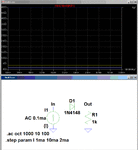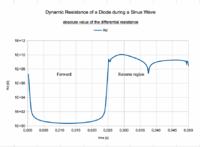neeraj786
Newbie level 5
how to calculate a dynamic resistance of a diode(Silicon) if i apply a sinusoidal wave (5V @ 20 HZ) and a resistance of 220 ohm is connected serially with diode ????
Follow along with the video below to see how to install our site as a web app on your home screen.
Note: This feature may not be available in some browsers.
AC makes things complicated.
Here is the way to calculate it with DC. (The peak of 5 VAC is 7.07 V DC.)
Subtract the diode drop. (Common practice is to use 0.6V, although a typical range is 0.4 to 0.8 V for 1N400x series.)
Assume the resistor is by itself. Calculate current through it.
( 7.07 - 0.6 ) / 220 = 29.4 mA
The identical current is going through the diode.
Therefore diode resistance is V / A.
0.6 / .0294 = 20.4 ohms
Its dynamic resistance will vary throughout a sine cycle. Between 20.4 ohms and infinity. That is through one half of the cycle. During the other half it is not conducting.
If you desire accuracy, then do further iterations. Recalculate the diode drop between iterations.

The results using the DC voltage across the diode as shown in erikl's post generates the apparent resistance, which includes the DC drop, not the dynamic resistance
sinusoidal wave (5V @ 20 HZ) and a resistance of 220 ohm is connected serially with diode

and get a meaningless number...(3) calculate the corresponding diode resistance (using the above process)
(4) average all the values